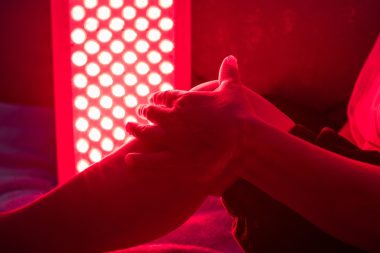How Natural Substances Like Bergamot Can Increase Photosensitivity
Red light therapy (RLT) has rapidly gained popularity for its ability to stimulate healing, improve skin quality, reduce inflammation, and enhance cellular energy.
But what if this already promising therapy could be made even more effective, simply by pairing it with natural compounds that increase photosensitivity and optimize the body’s light absorption?
The potential of this combination is not just exciting, but also opens up a whole new world of health benefits.
Enter the emerging “photo-sensitizing enhancement” field where nature and technology work together to unlock more profound health benefits. Among the stars of this space are essential oils and plant-based compounds like bergamot, curcumin, and chlorophyll, which may amplify the benefits of red and near-infrared light.
The Power of Red Light Therapy

Red light therapy delivers wavelengths of red (620–750 nm) and near-infrared light (750–1100 nm) deep into the skin and tissue. These wavelengths stimulate mitochondria… the “powerhouses” of our cells… to produce more ATP, the body’s energy currency. This increase in ATP production enhances cellular repair, reduces inflammation, and improves overall tissue health.
A review published in Seminars in Cutaneous Medicine and Surgery outlines how RLT promotes healing by modulating oxidative stress and stimulating cellular metabolism through mitochondrial chromophores like cytochrome c oxidase.
However, light absorption can vary depending on skin type, age, and cellular conditions. That’s where natural photo-sensitizing agents may help… by increasing skin responsiveness or improving intracellular uptake of photons.
Bergamot: A Natural Photosensitizer with a Bright Side
Bergamot oil contains furocoumarins, including bergapten, which sensitize the skin to light. This effect is well-documented in the context of PUVA therapy (psoralen + UVA) for psoriasis, where bergapten acts as a photoactive agent. Though PUVA uses UV light, the concept of enhancing light absorption through natural agents is directly relevant to RLT.
In one clinical application, bergamot derivatives were used in photochemotherapy to treat vitiligo and psoriasis, demonstrating their ability to improve outcomes when paired with light exposure. Though care must be taken to avoid overexposure or use in sunlight, small, diluted applications before red light sessions could enhance the absorption of red wavelengths deeper into the skin.
Chlorophyll and Plant-Based Light Receptors
Chlorophyll, the green pigment responsible for photosynthesis, has shown potential to enhance photodynamic therapies by acting as a natural light-absorbing molecule. Chlorophyll derivatives, such as chlorin e6, are already used in medical light therapies due to their strong absorption in the red and near-infrared range.
A study published in Photodiagnosis and Photodynamic Therapy found that chlorophyll-based photosensitizers when paired with red light, can trigger beneficial oxidative reactions that are highly localized… an effect that could translate into milder therapeutic uses like RLT for skin and wound healing.
Ingested chlorophyll may also support internal detoxification, increase oxygen uptake, and contribute to systemic skin improvement… possibly enhancing RLT from the inside out.
Curcumin: Anti-Inflammatory and Light-Responsive
Curcumin, derived from turmeric, has both anti-inflammatory effects and photoactive properties. A 2017 review in Phytotherapy Research noted that curcumin absorbs light in the 400–500 nm and 540–580 nm range, and when activated by light, it can enhance wound healing and inhibit inflammatory pathways.
Though curcumin degrades under prolonged exposure to light, short-term topical use before RLT may increase light absorption and antioxidant response in targeted tissues. Some experimental phototherapy studies using curcumin have even demonstrated antibacterial and anti-tumor activity when activated by red or blue light.
Risks and Considerations
Despite their promise, natural photosensitizers come with caveats. Bergamot oil can cause phototoxic reactions if misused. Chlorophyll and curcumin are generally safe, but bioavailability, formulation, and dosage must be considered to avoid unintended effects.
It’s crucial to be well-informed and cautious when using these substances to ensure their safety and effectiveness.
A key takeaway from the scientific literature is that delivery method and timing are crucial when combining photosensitizers with light therapy. Users should test tolerance with small amounts and ideally consult a healthcare provider before combining light and botanical compounds—especially if they have photosensitive skin or are on medications that increase light reactivity.
The Future of Light + Nature Synergy
As interest in biohacking and natural medicine grows, so does the potential to combine ancient plant wisdom with emerging phototherapy technologies. Personalized protocols may soon include combinations of topical oils, ingestible pigments, and tailored light wavelengths based on individual needs and goals.
Natural enhancers like bergamot, chlorophyll, and curcumin may offer safe, accessible ways to amplify the therapeutic effects of red light therapy. As more clinical studies emerge, the frontier of light-plant synergy may shine even brighter.
Ask your doctor if Red Light Therapy and natural photosensitizers are right for you.










